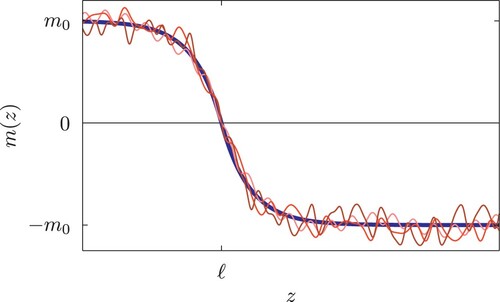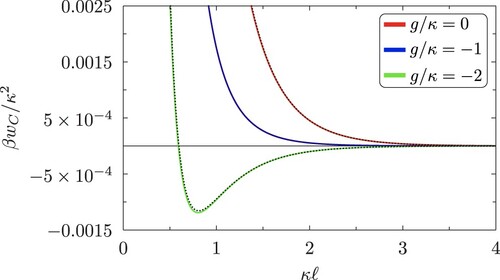Figures & data

Figure 1. Schematic illustration of the constrained MF magnetisation profile (smooth, thick, blue line) and small fluctuations around it (wiggly, thin, red lines) which also satisfy the crossing criterion that m = 0 at
. The MF profile is unique and determines the MF contribution to the binding potential
, while the myriad of distinct, small fluctuations, about
, which all correspond to the same interfacial configuration determines the additive entropic, or Casimir, contribution
.

Figure 2. The Casimir contribution to the binding potential for a wetting layer of uniform thickness ℓ, Equation (Equation3(3)
(3) ), illustrated for critical wetting (
), tri-critical wetting (
) and first-order wetting (g = 0). The dashed lines are the contribution from the leading order exponential term in the expansion of
which is near exact over the whole range of film thicknesses.

Figure 3. The divergence of the parallel correlation length and wetting layer thickness (inset) obtained using the numerical non-linear RG for critical wetting with allowing for a Casimir correction to the binding potential. The continuous dark line corresponds to the asymptotic prediction
[Citation7] which is only reached when
indicating that this regime is likely unobservable. The approach to this asymptotic regime is extremely broad and gradual with the growth of the correlation length for thinner films, being described by an effective exponent
(dashed line) very similar to that seen in Ising model simulations [Citation12].
![Figure 3. The divergence of the parallel correlation length and wetting layer thickness (inset) obtained using the numerical non-linear RG for critical wetting with ω=0.8 allowing for a Casimir correction to the binding potential. The continuous dark line corresponds to the asymptotic prediction ξ∥∼(t|lnt|0.3)−3.7 [Citation7] which is only reached when κξ∥>1010 indicating that this regime is likely unobservable. The approach to this asymptotic regime is extremely broad and gradual with the growth of the correlation length for thinner films, being described by an effective exponent ν∥eff≈2 (dashed line) very similar to that seen in Ising model simulations [Citation12].](/cms/asset/3250fcaf-61f6-45dc-9709-3a5f18bec669/tmph_a_2193654_f0003_oc.jpg)
